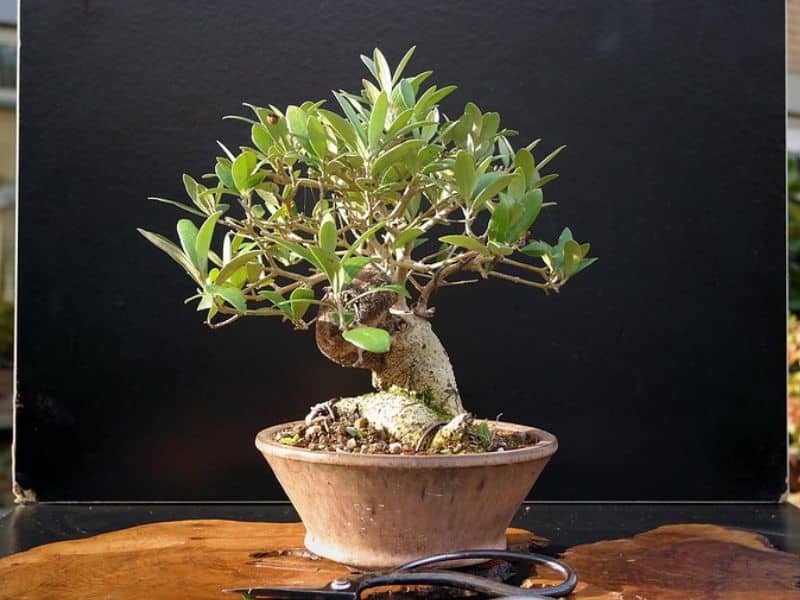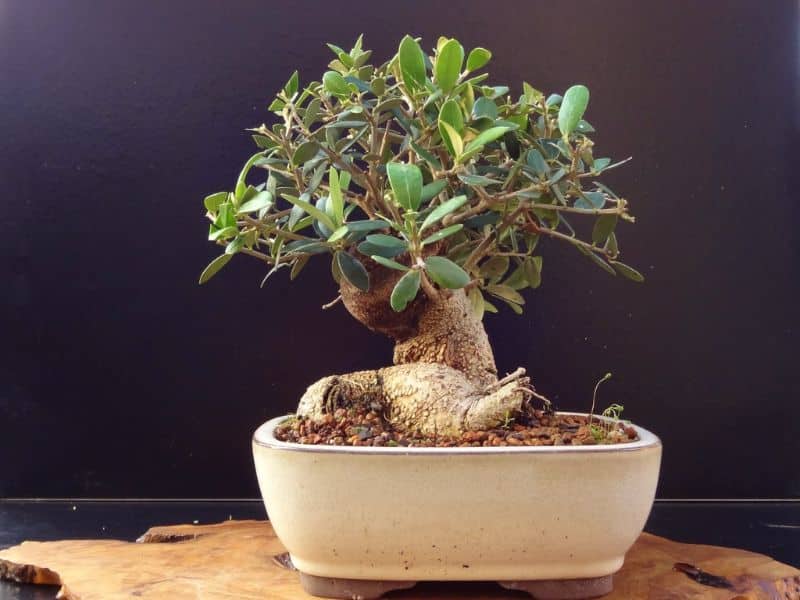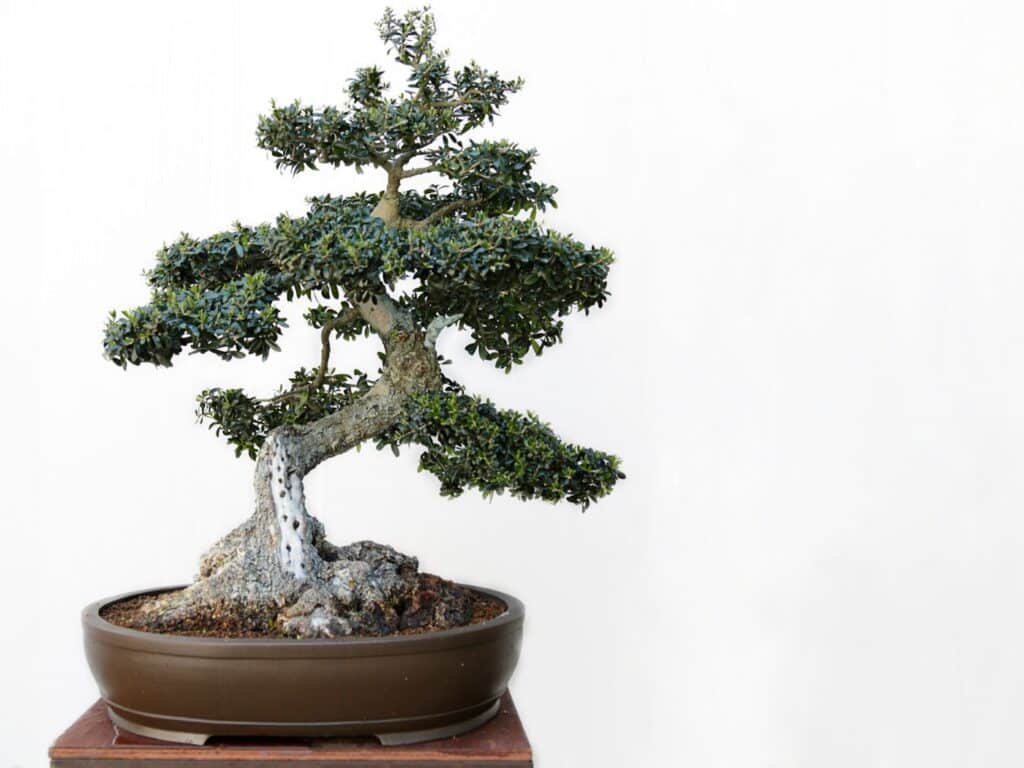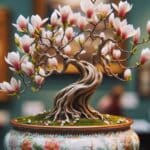It is believed that olive trees have a calming effect on the spirit and that this type of tree can restore balance to your spaces. Many also believe this tree helps reduce stress and enhance concentration levels because the leaves contain chemicals that affect your central nervous system.
While you might need more space in your office or home for a large 20-foot-tall olive tree, it is certainly possible to make room for a bonsai tree.
Olive bonsai trees offer the same benefits as those in their natural habitat. Still, these miniaturized versions look much more charming, especially if the little tree is appropriately trained and pruned. They are also straightforward to grow and care for and are often recommended for bonsai beginners.
In this guide, we will share some great tips on how to grow your own mini olive tree and take good care of it.

Plant Facts
| Scientific name | Olea Europaea |
| Common names | Wild olive, Common olive, Bonsai Olive Tree |
| Family | Oleaceae |
| Plant Type | Fruit tree, Small Tree |
| Height and Width | 20 – 30 ft. tall (natural), 1–3 ft. wide (indoors) |
| Origin | Native to Mediterranian Europe, Asia, and Africa |
| Flower colors | Creamy white, pure white, pale, deep yellow, or orange depending on the variety |
| Foliage color | Bright green to dark blue-green |
| Sun Exposure | Minimum of 6 hours of direct sunlight |
| Soil Type & pH | Well-drained, well-aerated soil |
| Special features | Low Maintenance. Good for Containers. Wonderful for Bonsai. Ideal for bonsai beginners. |
What Does an Olive Tree Bonsai Look Like?
Bonsai olive trees look very similar to adult trees, but their leaves are a bit larger in scale. The miniature trees differ from their natural stature since their dead wood tends to be whiter, and the cracked bark appears larger and thicker.
These small trees can be modified into just about any bonsai shape, but the free upright shape (Moyogi style) is one of the most common shapes for this tree species.
These sacred tree species are evergreen and are beloved for their striking blue-green foliage color, and they typically have tiny leaves. Depending on the variety, these bonsai trees can also bloom and produce flowers in colors like pure white, off-white, yellow, or orange.
The mini trees can also produce olives. You won’t get enough olives from your bonsai tree to have some olive oil, but the small fruit can give your tree a fascinating appearance.
Where Do Bonsai Olive Trees Grow?
Mediterranean olive bonsai trees can be grown in interior spaces with lots of light, but these trees need about 6 hours of direct sunlight. Most bonsai artists will keep these trees outside during the warmer summer or spring months and will then move these trees indoors during the winter months to protect the tree from frost.
You can also keep your bonsai in a frost-free greenhouse in colder climates. This tree can be kept outdoors in tropical regions throughout the year but should be protected from chilly winds.
How to Grow an Olive Bonsai Tree
Olive bonsai trees are some of the easiest bonsai species to grow and care for because they grow well in containers, respond well to heavy pruning, and don’t need much care. Even mature trees can be successfully transplanted into containers should you want to chop old trees down to transform them into bonsai.
Let’s look at the best way to grow your bonsai tree from olive branches or saplings.

Propagation
You can grow an olive tree from seed, cuttings, or through air layering.
Some growers also like to dig up young olive trees to top the tree off to produce a bonsai with a thick stem. Young bonsai trees will take well to containers even after being extracted from the ground, but it can be difficult to conceal the scar at the top of your bonsai tree if it has been cropped short.
Starting your outdoor bonsai tree with a sapling or cutting is usually best. Here is a closer look at the best way to propagate an olive tree.
Seed Germination
Olive seeds can take up to 3 months to germinate. To speed up this process, growers often physically damage the seed coat. Here are the steps for quickly growing your olive tree from seed.
- Start with a quality olive tree seed. You can buy or obtain the seed from some fresh ripe olives.
- Use a blunt knife or sandpaper to scratch into the seed coat at every end of the olive pit. Be careful not to damage the seed embryo on the inside.
- Plant the pit 3 inches deep in a container with some quality potting soil.
- Place the pot inside a clear polyethylene bag to retain some moisture, but don’t seal the bag entirely so the seed can still breathe.
- Keep the container in a well-lit, warm area, but avoid direct sunlight.
- Keep the seed moist until it sprouts.
Cuttings
It would help if you took some fresh cuttings from a suitable tree species to grow your olive tree from cuttings. Use a hammer or sever to crack the base of the cutting and dip this cracked end into some rooting hormone. Remove most leaves, but leave a few at the top of the cutting.
You can plant the cutting in a container with some potting soil mix. Keep the soil moist until the cutting produces roots. It should be kept in a well-lit, warm area without direct sunlight.
Air Layering
Air layering is a process that can also be used to grow your own sapling off another olive tree. For this method, you must scar the bark of a suitable branch while it is still attached to the mother plant.
Make deep cuts and remove the bark in the area where you want new roots to grow. Next, you must wrap moist sphagnum moss around the wounded area and completely seal off this wet moss with some plastic film so no moisture can escape.
Give some time for the cutting to produce some roots. Once the seeds are strong enough, you can saw off the branch and grow the cutting in a container.
Soil
It is essential to use a bonsai potting mix or cactus soil for any bonsai tree, mainly olive trees because they need well-aerated and well-draining soil.
A good soil mix for these trees is 25% pumice,50% Akadama, and 25% volcanic ash lava rock.
The soil should drain well; olive trees typically prefer a slightly alkaline pH of 7 – 7.
Pruning and Training
Strong pruning is recommended for olive tree bonsai because it encourages vigorous new growth. The best time to prune this tree is in late winter.
To prune the little tree, you can start by cutting off any unwanted branches or growth that is dying or damaged. New shoots that have grown too long can also be cropped short. You can also trim out some excessive inner growth, but it is important not to remove too much since these trees look best with a bushy appearance.
If you want your bonsai tree to have a specific growth pattern or bonsai design, then you should use wiring techniques to shape the branches and stem of the tree. It is best to wire the tree in late winter before the growing season starts.
Use aluminum wire or copper wire for wiring your little tree. Start by coiling the bonsai wire around the branches that you want to modify or adjust and bend these wired branches into a desired shape. You can also use guy wires to modify the direction of some thicker branches.
Olive trees have a slow growth rate, so you should be able to leave the wires on for about 3 months before they need to be removed.
Repotting and Transplanting
A young wild olive tree should be repotted every 3 – 4 years, but older specimens can be repotted infrequently. You can repot older olive trees once every 5 – 8 years if you keep pruning the tree often throughout the growing season.
Early spring is the best time for reporting olive trees because this is the time when the tree has a more vigorous growth rate.
It is best to plant your tree in a small shallow pot with lots of drainage holes, but choose something slightly larger than the root system to allow more room for growth.
To repot the small tree, carefully remove it from the old bonsai pot. Carefully loosen up all the soil around the roots with a root hook.
Cut away any excess roots. It is usually best to remove about one-third of the root system.
When planting your tree again, use a fresh soil mixture and carefully remove all air bubbles around the root system.
Keep the soil moist for a week or two so the roots can recover.
How to Care for an Olive Bonsai
After planting and training your bonsai tree, you will also need to take good care of it throughout the year. Here is a quick look at some great olive tree bonsai care tips that can help keep your tree healthy and vibrant throughout the year.
Water
Olive trees are hardy and they can survive dry spells. It is, however, best to water your small tree regularly. Allow your wild olive bonsai to dry out between waterings and water thoroughly when it is time to hydrate your tree. It is best not to use cold water since these trees don’t like cold temperatures. You can reduce watering during the winter months because this will help reduce the chances of developing root issues.
Sunlight
Olive trees need lots of direct sunlight in order to grow well. It is best to place it in a full-sun position, especially if you want your tree to bloom and bear fruits. Most growers prefer to keep their trees outside in the garden here they can easily get 4 – 8 hours of direct sunlight.
If you are keeping your tree indoors then you should position it in a sunny window where it will receive some direct sun for at least four hours of the day.
Temperature and Humidity
Olive trees are sensitive to the cold and should be moved indoors during cold winters. They grow best in temperatures of 41 degrees F up to 85 degrees F.
These trees can flourish in dryer or low-humidity conditions. They prefer an average humidity level of 40%. The humidity levels of your indoor bonsai can be raised by placing a humidity tray next to the small tree but you should be careful not to raise the humidity levels too much or the tree will become more susceptible to fungal diseases.

Fertilizer
These hardy trees can grow well in poor soil conditions but in bonsai form, they will need some fertilizer. It is best to apply solid organic fertilizer or liquid fertilizer regularly throughout the growing season. You don’t need to add fertilizers during the cold winter months because the tree will need some time to rest.
Pest and Diseases
Olive trees are usually pretty healthy and pest-free if they get enough air circulation and sunlight. You might sometimes struggle with a few pests or diseases like the following.
Aphids
Aphids or plant lice are sap-seeping pests that can make your plant’s leaves look all wrinkled and distorted. This type of pest infestation is usually treated with some pesticides.
Scale insects
Scale insects are small pests that can cover the stems and leaves of your plant. These infestations can be treated with a horticultural oil spray. This spray contains oil that clogs the breathing holes of the pests and kills them off.
Fungi
Fungi can also grow on the tiny leaves of your tree and can hinder the growth of these plants. This type of issue is usually caused by over-watering your tree or can occur when there is too much humidity in the air. The fungi can be treated with copper-based fungicides.
Common Varieties and Cultivars
There are hundreds of different cultivars or varieties of olive trees. The best cultivars to use for bonsai creations are species with smaller leaf patterns like the wild olive (Olea sylvestris). Most varieties can, however, be successfully turned into a bonsai. Other species might simply have a bigger leaf pattern and, as such, might be more suitable for larger bonsai creations such as imperial bonsai. Here is a quick look at some of the best cultivars to use for growing an olive bonsai.
- Wild Olive (Olea sylvestris)
- Common Olive (Olea oleaster)
- European olive (Olea europaea)
Conclusion
Olive bonsai trees are an excellent choice for improving interior spaces’ appearance, vibe, and air quality. This little tree can also add lots of charm to garden areas. They are ideal for bonsai beginners because they are easy to grow and care for.
We hope you enjoyed this guide and that it helps you grow a perfectly healthy tree and will enjoy all of the blessings that this tree might bring into your home or workplace.
Up next:
- Growing and Caring for a Bonsai Banana Tree (Musa acuminate)
- Growing and Caring for a Bonsai Avocado Tree (Persea Americana)
Image by RaquelPedrosa/depositphotos







